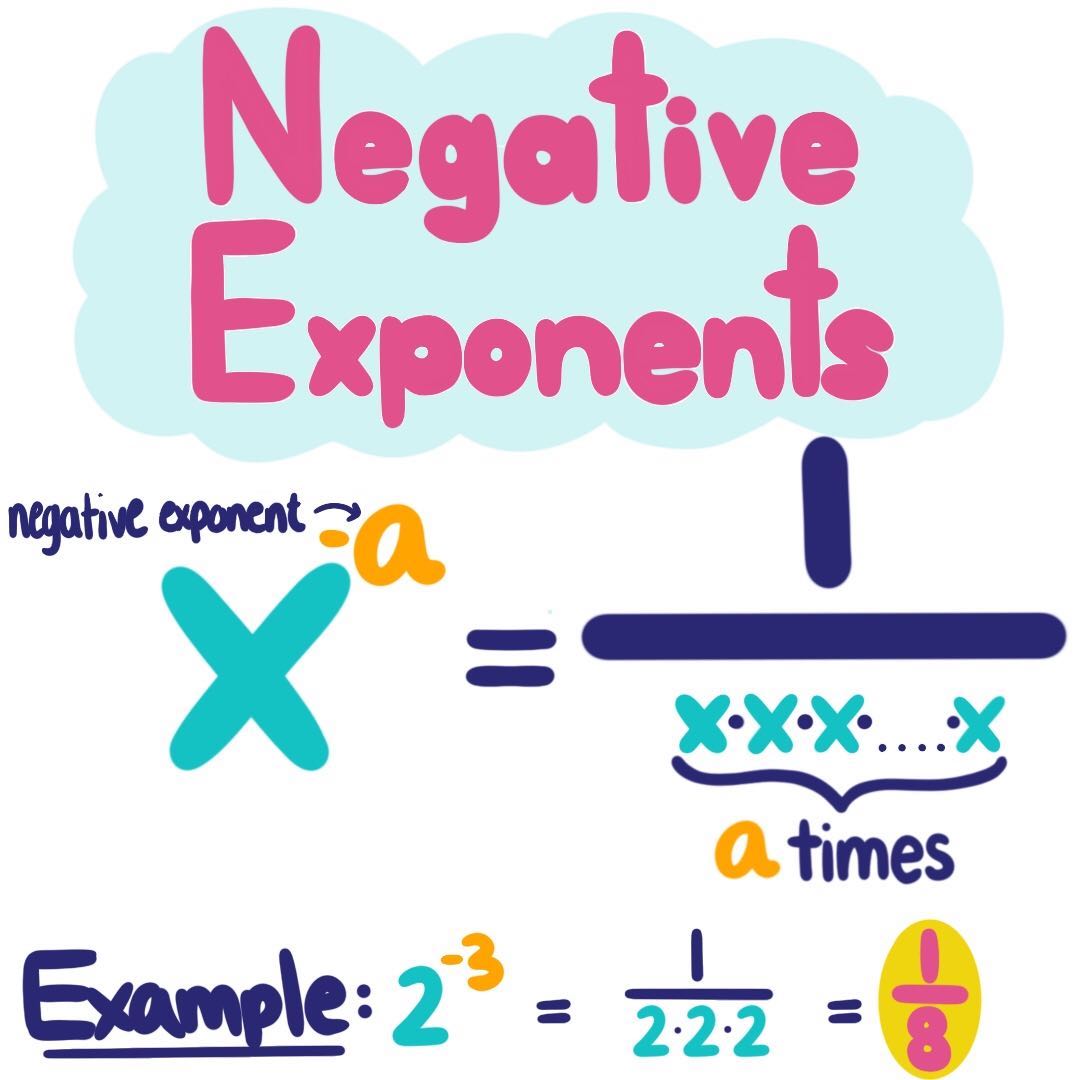The exponential term only places the decimal point. 5 5 25 Squaring a negative number also gets a positive result.

Negative Exponents Definition Rules Examples
A positive exponent indicates how many times a base number should be multiplied whereas a negative exponent indicates how many times a base number should be divided.

. 1 5 5 5 153 1125 0008. Thus 3 -2 is written as 13 2 Hence the value of 3 -2 is 19. It indicates how many times to divide by the base rather than multiply.
A negative exponent tells us how many times we have to multiply the reciprocal of the base. But that can be done an easier way. Answer 1 of 6.
A negative exponent means how many times to divide by the number. A negative exponent indicates that a base is on the fraction lines denominator side. A negative power outside of the parentheses indicates that you need to take the inverse of the base number or put it in the denominator.
A rational number exponent such as ie. In this case 3 becomes the fraction ⅓. 8A number raised to a negative exponent is negative.
Negative exponents such as x-n can be rewritten as 11 xn. In mathematical form it is expressed as follows. This is the equivalent of taking the reciprocal of the base if the base is b the reciprocal is b -1 removing the negative sign then computing the positive exponent as you would normally.
A negative exponent means how many times to divide by the number. Left fracxy right-n left fracyx rightn If you have a negative rational exponent do not let that confuse you. Whereas the negative exponent tells us how many times we have to divide the base number.
For instance 2-4 116 24 116 2x where x is the number used to raise 2 to the power of n. In other words a negative exponent indicates the inverse operation from a positive integer exponent. For example in 8 2 8 is the base and 2 is the exponentWe know that 8 2 8 8.
Not at all - stays the same. If is negative we first have to deal with the fact that the exponent is. Negative exponents are indicators of how many times you must divide the value of one by the given number.
Is it always never or sometimes. First make the exponent positive by applying the inverse as explained above. So to eliminate the negative exponent simply place the number and the accompanying exponent under one to make a fraction.
Parentheses are used in mathematics for grouping terms in. Note that in the discussion below is assumed to be a positive natural number ie. 2-3 also can be expressed as 123 or 18.
Squaring a positive number gets a positive result. 2 -3 1222. Thats actually a very good question because you have undoubtedly been told probably by teac.
In other words the negative exponent rule states that a negative exponent number should be placed in the denominator and vice versa. Negative exponents indicate that the number for which the exponent applies to should be placed under one. In scientific notation the digit term indicates the number of significant figures in the number.
A negative number in parentheses followed by an exponent indicates that the negative number is to be raised to the power indicated by the exponent. We know that the exponent of a number tells us how many times we should multiply the base. In other words the negative exponent describes how many times we have to multiply the reciprocal of the base.
There are no rules on how to calculate. 8-1 1 8 18 0125. For example -32 is the same as -3 x -3 which equals 9.
When converting from scientific notation to standard notation in which direction does a negative exponent indicate that the decimal point will be moved. 9 x 10-32 Thanks to anyone who helps right away and need right answer from the people who have already taken this test. Recall that a rational number is one that can be expressed as a ratio of integers like 214 or 25.
B -1 1 b n. A negative exponent shows that the decimal point is shifted that number of places to the left. Consider the 8-2 here the base is 8 and we have a negative exponent -2.
If is zero the exponent will have division by zero but division by zero is undefined. Evaluate 12a-4b2 a -2 and b 4 remember ato the negative 4 6. If a negative exponent applies to a fraction we invert the fraction or equivalently we divide 1 by the fraction.
5 5 25 Because a negative times a negative gives a positive. 8-2 is expressed as 18 2 18 18. Rational exponents combine powers and roots of the base and negative exponents indicate that the reciprocal of the base is to be used.
There is another way to express a negative exponent since a negative exponent means how many times it is divided by the number but it can be confusing and time consuming for large quantities. If an exponent indicates how many times the base number is multiplied by itself then why doesnt 3 with exponent of 1 equal 9 and 3 with an exponent of 3 equal 27. 5-3 1 5 5 5 0008.
An example of negative exponents is 3 -2. 5-3 could also be calculated like. Write in scientific notation.
8-1 1 8 18 0125. A fractional exponent indicates taking the root. 5-3 1 5 5 5 0008.
The opposite of multiplication is division so a negative exponent indicates that we must divide the number one by the base number as many times as the exponent indicates.

Negative Exponents Rules Examples Expii

0 Comments